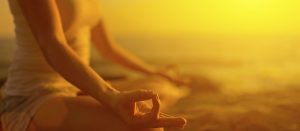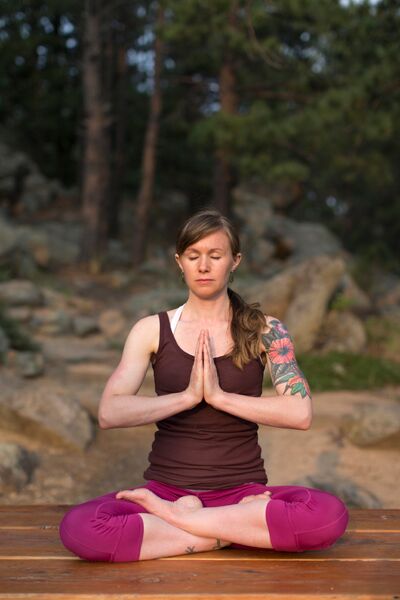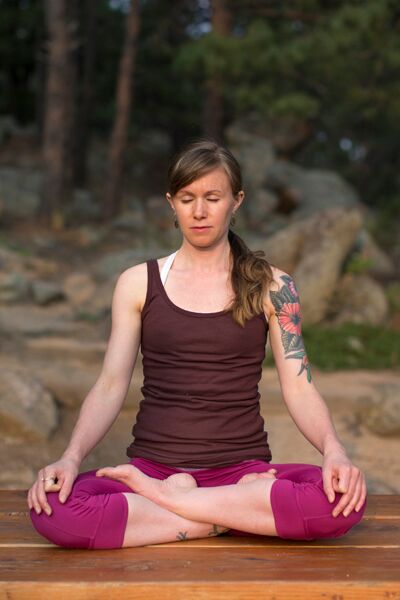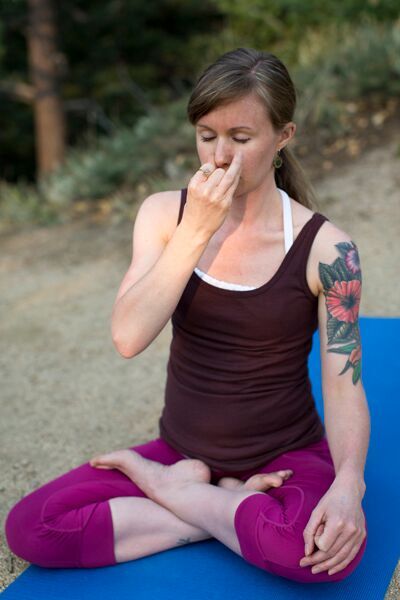 Pranayama is the powerful practice of controlling one’s breath. The health benefits are quite substantial, and generally speaking, include healing the mind, the nervous system and the physical body. Since Pranayama works so intimately with the subtle, energetic body it is of great importance to utilize the many different breathing variations properly. This will allow one to obtain the full benefits of the practice, as well as avoid harming the system further. Whatever your goals are for establishing a Pranayama practice, this article will share a bit of ancient knowledge with you to help get you started!
Pranayama is the powerful practice of controlling one’s breath. The health benefits are quite substantial, and generally speaking, include healing the mind, the nervous system and the physical body. Since Pranayama works so intimately with the subtle, energetic body it is of great importance to utilize the many different breathing variations properly. This will allow one to obtain the full benefits of the practice, as well as avoid harming the system further. Whatever your goals are for establishing a Pranayama practice, this article will share a bit of ancient knowledge with you to help get you started!
A Deeper Look into Pranayama:
The word pranayama is often translated as controlling the breath. Although this touches on a more superficial idea of this term, it doesn’t go into the depth of its true meaning. To really depict this word, we must break it down into the words that make up the compound pranayama. This is precisely “prana” and “ayama” (not to be mistaken with “yama” as often thought). These base words show the true meaning and potential of the word.
Prana can be translated as our vital life force and also can denote constant motion. In a more Ayurvedic aspect of Prana, it is termed as the pure essence of Vata dosha and is life energy that performs respiration, oxygenation and circulation in the body. This Pranic force enkindles our central bodily fire (Agni), and the natural intelligence of the body is expressed and controlled through the activation of Prana. Prana is said to control our higher cerebral activities including functions of the mind, memory, thoughts and emotions. The physiological functioning of the heart is also governed by Prana. From here Prana is able to enter the blood stream, thus delivering oxygen to all of our bodily tissues and vital organs.
The practice of Pranayama in one’s daily life will therefore nurture and enhance not only the physical body, but also go much deeper into the subtle, energetic and emotional body as well.
Ayama refers to a lengthening or a process of prolonging. This can be thought of through the Yogic belief that the lifespan is not determined by a number of years but actually by the number of respirations we take. Therefore by this process of lengthening or prolonging the breath, we are in fact prolonging and conserving our lifespan.
On the other hand, the fast, shallow breathing that occurs during stressful situations (including intense exercise) and which tend to be typical in our often chaotic daily life, is indeed decreasing and diminishing our vital life energy.
The Four Phases of the Breath
- Puraka– inhalation
- Rechaka– exhalation
- Antara Kumbhaka– inhale retention
- Bahya Kumbhaka– exhale retention
***Note: There is another phase that goes beyond these four. This is Kevala Kumbhaka which is the voluntary and total cessation of the breath. The Prana here is able to circuit and function completely on an inward level.

Beginning the Practice of Pranayama
“Having established the practice of asana, a yogi, who is self-restrained and consumes wholesome moderate food, should undertake the regular practice of pranayama, as instructed by a guru.” Hathapradipika ch4 vs1
This concise verse that begins the chapter on Pranayama in the Hathapradipika is revealing many messages. The first is that a practitioner should already be accomplished in the previous limbs of Yoga, verily Yama, Niyama, and Asana. This is the proper preparation in both a physiological and psychological sense, as the body and the mind need to be properly conditioned (or unconditioned as may be) in order to really obtain the benefits of pranayama.
This verse is also stating that one needs to be controlled in their diet and should perform the proper cleansing methods (Shat Karmas) before the yogi can be truly prepared. Last and possibly most importantly, the student needs to be in the presence of a knowledgeable teacher in order to get the proper guidance and supervision that is most vital.
Pranayama is like nectar to the body, mind and spirit when performed consistently and with the proper techniques. However, when pranayama is performed prematurely and without the proper guidance, it is sure to create disease and disturb the mind.

Proper Guidelines for Daily Practice*
*Courtesy of: Light on Yoga by B.K.S Iyengar
Cleanliness and Food
1. Just as you would not enter a temple with a dirty body or mind, one should enter the temple of his body by observing cleanliness. If nothing else one should wash the hands, face and feet and begin from a pure space in the mind (sattva).
2. If possible, evacuate the bowels before beginning as this will create a more comfortable setting.
3. Pranayama as with Yoga should be practiced on an empty stomach. This is one reason it is typically best practiced first thing in the morning. If this is not possible try to allow about 6 hours after a meal to allow proper digestion. Light food and drink may be taken a half hour after the practice.
4. As with Asana practice, it is contraindicated to drink fluids directly before and especially during the practice.
Time and Place
1. The best time for practice is first thing in the morning, preferably before sunrise. Pranayama may also be practiced after sunset.
2. Pranayama should be practiced in a clean, quiet space with abundant fresh air. This space should be free from noise, insects and distractions.
3. Pranayama is only beneficial when practiced with focus, determination and consistency. This means it is to be practiced daily and preferably at the same time and the same space. Variation in the style of Pranayama is appropriate and preferred as long as one is guided by an informed instructor. However, Nadi Shodhana (alternate nostril breathing) is stated to be practiced everyday.
4. A woman should never practice pranayama or asana on her Moon days.
Posture and Performance
1. Breathing in Pranayama practice should be done through the nose only except when specified otherwise (i.e. shitali or sitkari).
2. Pranayama is best done on the floor, on a folded blanket. Suitable postures are padmasana (lotus pose), virasana (hero’s pose), badhakonasana (butterfly pose), swastikasana, and siddhasana. The last two mentioned are for the advanced practitioner and need to be taught by a knowledgeable teacher. If these seated postures are not accessible by the practitioner, sukhasana (easy seat) can be utilized, granted that the entire spine remains erect, straight and perpendicular to the floor.
3. Make sure to check in with the body and release any unneeded tension in the body and muscles. This includes the arms, legs, feet, hands, face, tongue, shoulders, ect.
4. It is highly recommended that one should have prior experience and practice of the three bandhas (mula, jala, and uddiyana). These three bandhas are of vital use during pranayama and the correct application constitutes the foundation of the practice.
5. It is recommended to keep the eyes closed during the practice as distractions may occur otherwise. With the eyes open they may also feel a burning sensation and irritability.
6. Practice of Pranayama should not be performed before the practice of Asana, as the equanimity created in the mind and body during the breathing practice will be disturbed by these bodily movements. If performed in conjunction, the Pranayama should be applied directly after a mild Asana practice. If fatigue is there, just utilize the Ujjai breath in a reclined position as this will restore energy.
7. After the completion of any Pranayama practice one should rest in Shavasana (corpe’s pose) and allow the breath to come back to a neural rhythm. The practitioner should remain here for 5-10 minutes in complete silence. This will restore and refresh the body and the mind. If otherwise preferred, this recommendation can be replaced by a seated meditation, neutralizing the breath and remaining for at least 5 minutes. This seems to be more appropriate for a morning practice, where as Shavasana seems to work better for a nighttime practice.

The General Benefits of Pranayama
It has been stated that to control one’s breath, one can control the mind. The breath and the mind are intimately linked and if the breath is quick and shallow, it most likely is true that the mind is racing around as well. In order to gain control over our ever playful mind, we first must begin by gaining control of our breath.
Each specific Pranayama technique will have its own specified benefits. A few general overall benefits of Pranayama include:
- Increases Prana (the life forces) throughout the body and mind
- Calms the mind and the entire nervous system
- Restores and rejuvenates the mind and the nervous system
- Removes fatigue
- Removes obstructions and stagnant energy throughout the channels (nadis) in the body
- Balances the emotions
- Allows repressed emotions to arise and process
- Removes excess phlegm from the lungs and sinuses
- Strengthens the respiratory system
- Beneficial in asthma and other breathing disorders
- Allows one to deepen the breath thus bringing oxygen and circulation to more areas of the body. This will inevitably bring more life and vitality throughout and nourish deep into the tissues (dhatu)
- Allows one to cultivate an awareness of the breath and learn to calm and control the breathing
- Balances Vata, Pitta and Kapha dosha (depending on the specific technique)
Words of Caution
It cannot be stressed enough that a practitioner needs not only to work slowly and cautiously with the Prana (breath), but also should be instructed by a competent teacher or guide. This is clearly stated in the Hathapradipika.
“As one can gradually tame a lion, elephant or a tiger, similarly, Prana should be controlled slowly; otherwise it can cause great harm to the sadhaka (mind).”
“A judicious practice of Pranayama will alleviate all the ailments. An improper practice, on the contrary, gives rise to all diseases.”
“The faulty course of Prana causes several disorders such as hiccup, cough, asthma, and pain in the head, ears and eyes.”
Hathapradipika Ch4 Vs23-25
Click here to see our full apothecary menu.




